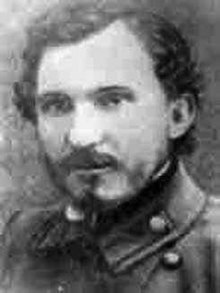Mikhail Suslin
Mikhail Y. Suslin | |
|---|---|
 | |
| Born | 15 November 1894 Krasavka, Saratov Oblast |
| Died | 21 October 1919 (aged 24) Krasavka, Saratov Oblast |
| Scientific career | |
| Fields | General topology, descriptive set theory |
Mikhail Yakovlevich Suslin (Russian: Михаи́л Я́ковлевич Су́слин; November 15, 1894 – 21 October 1919, Krasavka) (sometimes transliterated Souslin) was a Russian mathematician who made major contributions to the fields of general topology and descriptive set theory.
Biography
[edit]Mikhail Suslin was born on November 15, 1894, in the village of Krasavka, the only child of poor peasants Yakov Gavrilovich and Matrena Vasil'evna Suslin.[1] From a young age, Suslin showed a keen interest in mathematics and was encouraged to continue his education by his primary school teacher, Vera Andreevna Teplogorskaya-Smirnova. From 1905 to 1913 he attended Balashov boys' grammar school.[2]
In 1913, Suslin enrolled at the Imperial Moscow University and studied under the tutelage of Nikolai Luzin.[1] He graduated with a degree in mathematics in 1917 and immediately began working at the Ivanovo-Voznesensk Polytechnic Institute.[2]
Suslin died of typhus in the 1919 Moscow epidemic following the Russian Civil War, at the age of 24.
Work
[edit]His name is especially associated to Suslin's problem, a question relating to totally ordered sets that was eventually found to be independent of the standard system of set-theoretic axioms, ZFC.
He contributed greatly to the theory of analytic sets, sometimes called after him, a kind of a set of reals that is definable via trees. In fact, while he was a research student of Nikolai Luzin (in 1917) he found an error in an argument of Lebesgue, who believed he had proved that for any Borel set in , the projection onto the real axis was also a Borel set.
Publications
[edit]Suslin only published one paper during his life: a 4-page note.
- Souslin, M. Ya. (1917), "Sur une définition des ensembles mesurables B sans nombres transfinis", C. R. Acad. Sci. Paris, 164: 88–91
- Souslin, M. (1920), "Problème 3" (PDF), Fundamenta Mathematicae, 1: 223, doi:10.4064/fm-1-1-223-224
- Souslin, M. Ya. (1923), Kuratowski, C. (ed.), "Sur un corps dénombrable de nombres réels", Fundamenta Mathematicae (in French), 4: 311–315, doi:10.4064/fm-4-1-311-315, JFM 49.0147.03
See also
[edit]References
[edit]- ^ a b O'Connor, John J.; Robertson, Edmund F. (March 2011). "Mikhail Yakovlevich Suslin". MacTutor History of Mathematics Archive. University of St Andrews.
- ^ a b Igoshin, V. I. (1996). "A short biography of Mikhail Yakovlevich Suslin". Russ. Math. Surv. 51 (3): 371–383. Bibcode:1996RuMaS..51..371I. doi:10.1070/RM1996v051n03ABEH002905. S2CID 250856671.

